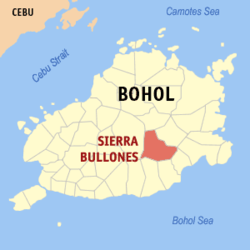Sierra Bullones | |
|---|---|
| Municipality of Sierra Bullones | |
 Sierra Bullones, Bohol | |
| Nickname: Golden Town of Bohol | |
 Map of Bohol with Sierra Bullones highlighted | |
Location within the Philippines | |
| Coordinates: 9°49′N124°17′E / 9.82°N 124.28°E | |
| Country | Philippines |
| Region | Central Visayas |
| Province | Bohol |
| District | 3rd district |
| Founded | 5 January 1863 |
| Barangays | 22 (see Barangays) |
| Government | |
| • Type | Sangguniang Bayan |
| • Mayor | Michael Doria (suspended) [2] Dodie Maestrado (acting) |
| • Vice Mayor | Patrick Unajan |
| • Representative | Kristine Alexie B. Tutor |
| • Municipal Council | Members |
| • Electorate | 18,517 voters (2025) |
| Area | |
• Total | 198.87 km2 (76.78 sq mi) |
| Elevation | 558 m (1,831 ft) |
| Highest elevation | 874 m (2,867 ft) |
| Lowest elevation | 41 m (135 ft) |
| Population (2024 census) [4] | |
• Total | 26,154 |
| • Density | 131.51/km2 (340.62/sq mi) |
| • Households | 5,892 |
| Economy | |
| • Income class | 3rd municipal income class |
| • Poverty incidence | 33.63 |
| • Revenue | ₱ 191.5 million (2022) |
| • Assets | ₱ 539 million (2022) |
| • Expenditure | ₱ 147 million (2022) |
| • Liabilities | ₱ 77.72 million (2022) |
| Service provider | |
| • Electricity | Bohol 2 Electric Cooperative (BOHECO 2) |
| Time zone | UTC+8 (PST) |
| ZIP code | 6320 |
| PSGC | |
| IDD : area code | +63 (0)38 |
| Native languages | Boholano dialect Cebuano Eskayan Tagalog |
Sierra Bullones, officially the Municipality of Sierra Bullones (Cebuano : Munisipyo sa Sierra Bullones; Tagalog : Bayan ng Sierra Bullones), is a municipality in the province of Bohol, Philippines. According to the 2020 census, it has a population of 26,095 people. [6]
Contents
- Etymology
- History
- Geography
- Barangays
- Climate
- Demographics
- Economy
- Gallery
- References
- External links
It is 71 kilometers (44 mi) from Tagbilaran.
Sierra Bullones celebrates its fiesta on December 8, to honor the town patron, the Immaculate Concepcion. [7]




